Famous People, Water Snakes and Chinese Astrology
What make these people famous?
Different people are famous for different reasons - some good, some bad.
They became famous because they contributed some significant event or change in the world. Usually, we get to know these famous people through our friends or colleagues and the printed or electronic media. Oftentimes, we have some perceptions of them in our minds. How we think or feel about them had been influenced in one way or another by their actions or personalities.
We feel some kind of admiration, reverence, honor, respect, praise, affection, contempt, prejudice, condemnation, dislike, disapproval, and hatred.
Here are some of these famous people who have had enhanced our experiences and maybe our lives as well:
Famous "Water Snake" People In History

Famous People Born In February 17, 1893 to February 4, 1894
Mao Zedong
Born: December 26, 1893
World Leader, Political Leader
Chinese communist revolutionary, political theorist and politician
Founding father of the People's Republic of China
José María Velasco Ibarra
Born: March 19, 1893
World Leader, Political Leader
President of Ecuador (1934–35, 1944–47, 1952–56, 1960–61, 1968-1972)
Huey Long
Born: August 30, 1893
Lawyer, U.S. Senator from Louisiana
Governor, U.S. Representative
Famous motto "Every Man a King"
Dorothy Parker
Born: August 22, 1893
Civil Rights Activist, Journalist, Poet
Founder member Algonquin Hotel's "Round Table,"
famous for hosting the wittiest debates and banter
Walter White
Born: July 01, 1893
Journalist, Novelist
Civil Rights Activist
Led the National Association for the
Advancement of Colored People (NAACP)
Dorothy Thompson
Born: August 09, 1893
Radio Personality, Journalist
Known as “First Lady of American Journalism”
John Marquand
Born: November 10, 1893
Author, Pulitzer Prize Winner
Known for Mr. Moto spy stories
Lillian Gish
Born: October 14, 1893
Film, TV and Theater Actress
Known as "The First Lady of American Cinema"
Mae West
Born: August 17, 1893
Film and Theater Actress, Playwright, Screenwriter
Sex Symbol, Pin-up Girl
Edward Robinson
Born: December 12, 1893
Actor
Known for his "tough guy" roles
Harold Lloyd
Born: April 20, 1893
Film Actor, Comedian
Icon of silent film era
Andrés Segovia
Born: February 21, 1893
Spanish Classical Guitarist
Important force in making the guitar
a concert instrument
Blind Lemon Jefferson
Born: September 24, 1893
Guitarist, Singer, Songwriter
Known as a blues guitarist
Joan Miró
Born: April 20, 1893
Painter, Sculptor, Ceramicist
Known for Surrealism works of art
Francis Ouimet
Born: May 08, 1893
Golfer
Known as "Father of Amateur Golf"
First American elected Captain of the Royal and Ancient Golf Club of St Andrews
This list has three prominent world leaders/politicians; three civil rights activists/journalists; two writers/journalists; four famous actors/actresses: two musicians; one artist; and one sportsman.
What is the link among these famous people?
Yes, they were born in February 17, 1893 to February 4, 1894 - the Chinese Astrological Year of the Water Snake.
Now, let's take a look at another list of famous people who were born 60 years later in 1953. Many of these celebrities are still around and we can somehow relate to them. They are also "Water Snake" people according to Chinese Astrology.
Famous "Water Snake" People Born In February 14, 1953 to February 2, 1954

Famous Water Snake People Born In February 14, 1953 to February 2, 1954
Tony Blair
Born: May 06, 1953
World Leader and Politician
Environmental Activist, Lawyer, Prime Minister
Prime Minister of the United Kingdom (1997 - 2007)
Benazir Bhutto
Born: June 21, 1953
World Leader and Politician
Former Prime Minister of Pakistan
First female P.M. of a Muslim nation
Jean-Bertrand Aristide
Born: July 15, 1953
World Leader, Politician and Priest
Former President of Haiti
Xí Jìnpíng
Born: 15 June 1953
World Leader, Politician
Vice President of China,
General Secretary of the Communist Party of China,
Next President of China
Elaine L. Chao
Born: March 26, 1953
Political Leader
24th US Secretary of Labor (2001-2009)
First Asian Pacific American woman and
first Chinese American appointed to a
President (George W. Bush)'s cabinet in American history
Leonel Fernández Reyna
Born: December 26, 1953
World Leader and Politician, Lawyer
President of the Dominican Republic (2004-2012) and (1996-2000)
Ségolène Royal
Born: September 22, 1953)
French politician, former Government Minister
Robert B. Zoellick
Born: July 25, 1953
Business Leader, Government Official
11th President of the World Bank (2007-2012)
Ben Bernanke
Born: December 13, 1953
Economist, Chairman of the Federal Reserve System (2006)
Patricia Dunn
Born: March 27, 1953
Business Leader
Former Chairwoman of the Board of Hewlett-Packard Company
Oprah Winfrey
Born: January 29, 1954
Film Actress, Philanthropist,
Talk Show Host, TV Producer, Publisher
Meredith Vieira
Born: December 30, 1953
Talk Show Host, News Anchor
Emmy Award-winning TV Journalist
Pierce Brosnan
Born: May 16, 1953
Animal Rights Activist, Environmental Activist,
Anti-War Activist, Film and TV Actor,
Entrepreneur, Producer
Kim Basinger
Born: December 08, 1953
Animal Rights Activist, Film Actress
Tim Allen
Born: June 13, 1953
Film and TV Actor, Comedian
Chaka Khan
Born: March 23, 1953
Actress, Songwriter, Singer
Cyndi Lauper
Born: June 22, 1953
Songwriter, Singer
Cornel West
Born: June 02, 1953
Educator, Philosopher, Scholar,
Civil Rights Activist, Academic Author
This list has seven prominent world leaders/politicians; two financial experts; one business leader; two talk show hosts/TV celebrities/writers; two animal-rights activists/film stars: one actor/comedian: two songwriters/singers; and one philosopher.
Common link? They were born in the Chinese Astrological Year of The Water Snake (February 14, 1953 to February 2, 1954).
Now, let's find out more about what Chinese astrology has to say about "snake people" especially those born in the years of the Water Snake.
2013 - Year of The Snake
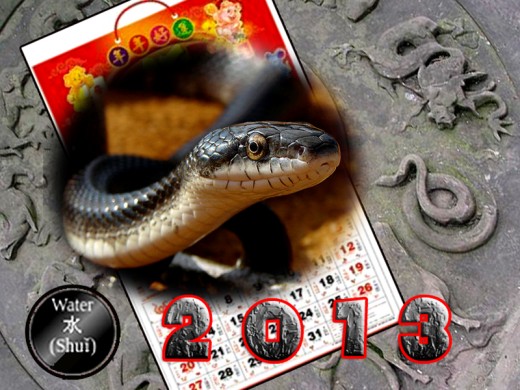
Year of The Snake
New Year in the Gregorian calendar always fall on January 1 but in the Chinese lunisolar calendar, Chinese New Year does not fall on a specific date. It falls between January 21 to February 20. The Chinese New Year for 2013 begins on February 10 and ends on January 30, 2014.
Among Chinese people all over the world, the year 2013 is popularly known as the Year of the Snake. It is the sixth animal of the twelve-year cycle of Twelve Animals in Chinese astrology.
The following years were Snake years:
1893 * 1905 * 1917 * 1929 * 1941 * 1953 * 1965 * 1977 * 1989 * 2001
For those who are into Chinese astrology, 2013 is also referred to as the Year of The Water Snake or Black Water Snake.
Western Perceptions of Snakes and Snake Symbols
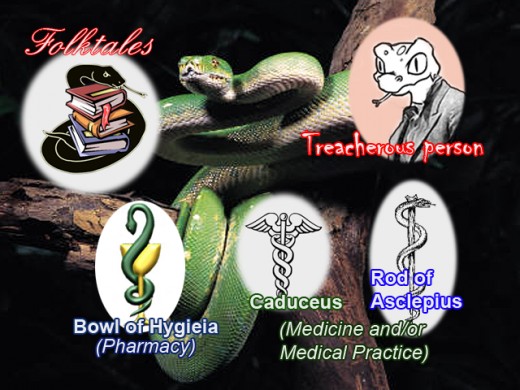
The Snake - Deadly and Docile, Good and Evil
The Snake or Serpent symbol has always been perceived as a dual symbol representing both good and evil, life and death, creation and destruction. How we view the snake depends very much on the culture in which we are brought up.
In the West, the snake is frequently portrayed as evil. It represents Satan in the Garden of Eden where Adam and Eve ate the forbidden apple. Many folktales portray the snake in a negative way and a treacherous person is often referred to as "a snake".
However, in medicine, snake symbols are still used today such as Bowl of Hygieia, symbolizing pharmacy, and the Caduceus and Rod of Asclepius, which are symbols denoting medicine and/or medical practice, especially in North America.
Chinese Perceptions of The Snake
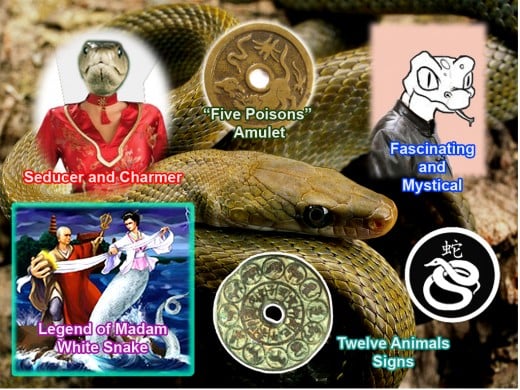
Chinese Feared As Much As Admired The Snake
In China, ancient folklore and astrological traditions view the snake as a dangerous and mysterious creature equally feared and admired by the common folk.
The snake is one of the "five poisons" associated with five poisonous animals - the snake, scorpion, centipede, toad and spider. Wild snakes were prevalent during the hot summer months and they would wait patiently and strike like lightning to make a kill. Anxious Chinese parents often have their children wear a "five poisons" amulet bearing the images of the "five poisons" to counteract harmful or fatal influences.
Over the centuries , ancient Chinese astrologers believed many people born in the year of the snake are shrewd in business affairs. They perceived that these persons have the same personalities of the snake for they both often plan carefully and wait patiently to make a killing when they intuitively judge the moment is right.
There is an ancient Chinese saying that portrays a Snake person in the house as a good omen because it means the family will be well taken care of. Many Chinese astrologers believed that a Snake person has good luck and does not have to worry about money for it is always available when needed. The Snake is also believed to be very compassionate towards family members.
One of the most famous Chinese story about snakes is the legend of "Lady White Snake" that tells of a young scholar who falls in love and marries a beautiful girl named Lady White (or Madam White) who was actually a 1,000-year old white snake demon who wanted to do good deeds in the world.
Did the snake demon seduced the scholar? Or did he fell madly in love because of her beauty?
Over the centuries, this snake legend has been retold in various versions and in many forms including Chinese operas, movies and political interpretations. This story has changed drastically from its ancient beginnings over the years.
Nowadays, Lady White is portrayed as a compassionate heroine in her quest for love instead of a sly man-eating snake demon.
Chinese astrologers believed many snake persons have a strong, charismatic aura radiating a charm best described as "bewitching" or "beguiling." They are beautiful people with sex appeal and are generally accepted as great seducers or charmers. They are often very popular and people just love to be around them.
Chinese Astrology - Complex or Simple, Serious or Fun
Unlike western zodiac, Chinese astrology does not rely solely on direct observations of the stars but has a close relation with Chinese philosophy and culture. It is based on Chinese concepts of the universe, cycles of years, lunar months, and two-hour periods of the day and observations of people born under the different animal signs.
Chinese astrologers use different concepts and systems for predicting and foretelling a person's individuality and destiny based on one's birthday, birth season, and birth hours, birth place and many other factors.
Compiling a person's Chinese horoscope is a very ancient art. It can be very complex and precise or it can be very general and simple.
Some people, especially politicians, celebrities and the rich, take Chinese astrology very seriously and would want to know about their fate, luck attraction, career directions, health, compatibility with other people and lots more.
On the other hand, many others want to have fun just knowing what astrologers say about their personalities and fortunes.
Chinese Astrology Uses Many Theories and Concepts
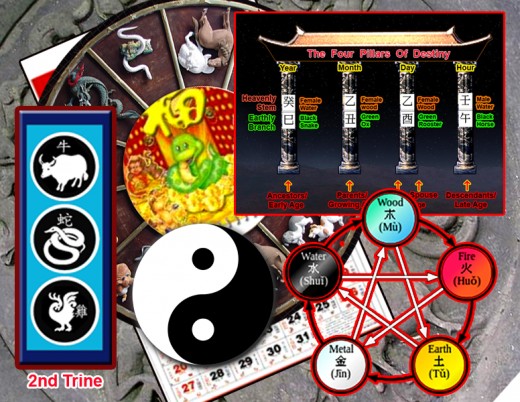
Understanding Chinese Astrology
The following are five common theories and concepts of Chinese philosophy and culture that you should know to understand Chinese Astrology and what it says about the Snake especially the Water Snake:
- The cosmic power called Yin and Yang that symbolizes the universal harmony;
- The Five Elements of Wood, Fire, Earth, Metal and Water;
- The Twelve Animals comprising the Rat, Ox, Tiger, Rabbit, Dragon, Snake, Horse, Sheep, Monkey, Rooster, Dog and Pig;
- The Four Trines or group of three animals having its own characteristics; and
- The Four Pillars of Destiny/Life encompassing the Eight Characters.
There are many more theories, concepts and methods that Chinese astrologers and fortune-tellers used in divination, for examples, Purple Star Astrology, Face Reading, Palm Reading. The Four Pillars of Destiny is the most popular and accessible and will be discussed here.
Cosmic Power Called Yin and Yang
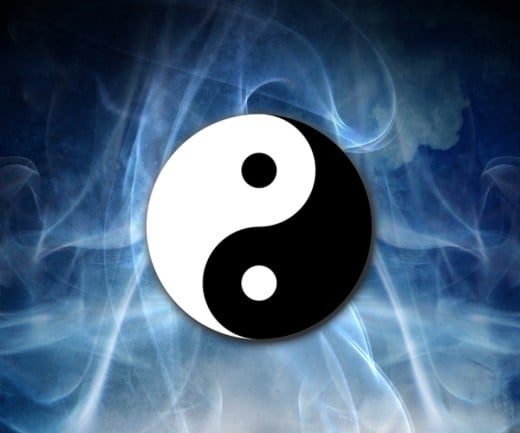
Yin and Yang
Ancient Chinese philosophers believed that there are two natural forces - complementary and contradictory - to every phenomenon in the universe. The two forces are different, but they mutually support and oppose each other to achieve balance and harmony. They called these two forces Yin and Yang and accepted this concept as the basic law of the universe. They also used this Yin-Yang concept to explain all social phenomena. Chinese astrologers use this concept extensively to analyze and predict a person's destiny.
Yin has the following characteristics:
passive, negative, darkness, earth, north slope, cloudy, water, softness, female, moisture, night-time, downward seeking, slowness, consuming, cold, odd numbers, and docile aspects of things.
Yang has the following characteristics:
active, positive, brightness, heaven, south slope, sunshine, fire, hardness, male, dryness, day-time, upward seeking, restless, producing, hot, even numbers, and dominant aspects of things.
In Chinese astrology, the Yin or Yang is broken down into Five Elements comprising Wood, Fire, Earth, Metal and Water.
Basic Constituents of The Universe
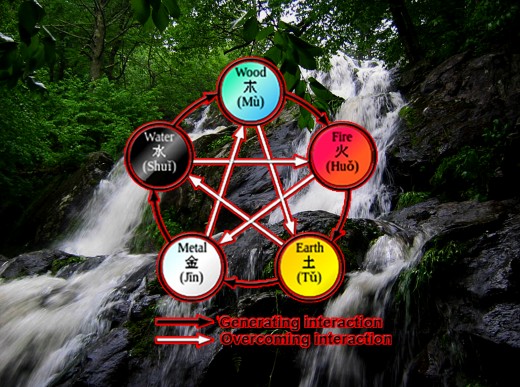
Five Elements
Chinese believed that these Five Elements of Wood, Fire, Earth, Metal and Water constitute the basic foundation on which the universe is built with the five elements balanced in supporting and opposing each other to achieve harmony.
The Five Elements concept extends over everything in the universe including space and time.
In Chinese astrology, it is associated with the Twelve Animals, Colors, Directions, Seasons, Sounds and Daily Lives. It is also link to the Years, Months, Days, Hours, Minutes and Seconds of the Chinese calendar.
The Five Elements are greatly influenced by their Yin and Yang forces. They are moving back-and-forth and constantly changing. Just like Yin and Yang, the movements of five elements are in balance when they are slow and stable indicating peace and fortune in a person's destiny.
If the the Yin and Yang forces are out of balance, then the movements are unstable and unpredictable indicating turmoil and bad luck.
Chinese astrologers regard the Five Elements as modifiers which affect the original personalities of each of the Twelve Animals. Thus, each animal is governed by either a Yin or Yang Element, Direction and Season.
The balance of Yin and Yang and the Five Elements in a person's individuality has a major influence on what is beneficial and effective for the person's destiny. This is because each element is linked to a particular direction and season and their different kinds of life force energy called Qi or Chi in Chinese.
In traditional Chinese culture, qì or chi is an active principle that constitutes part of any living thing. Qi is also translated as life energy or energy flow and is similar to the ancient doctrine of vital energy in Western philosophy.
Heavenly Stems and Earthly Branches
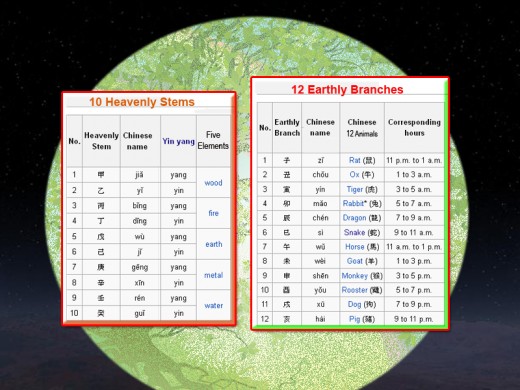
Chinese Calendar- Heavenly Stems and Earthly Branches
The Chinese lunisolar calendar was first introduced by Emperor Huan Ti in 2637 BC. It is based on astronomical observations of the sun's longitude and the moon's phases. It indicates both the phase of the Moon and the time of the solar year.
Instead of counting the years, Chinese astronomers use the ten Heavenly Stems and twelve Earthly Branches to record or name the years and this Stem-Branch expression of year has a cycle of sixty years.
The ten Heavenly Stems are associated with the duality of Yin and Yang and the Five Elements.
The twelve Earthly Branches are associated with the twelve signs of the Chinese "Twelve Animals" which starts with the Rat, Ox, Tiger, Rabbit, Dragon, Snake, Horse, Sheep, Monkey, Rooster, Dog and ends with the Pig. Animal signs are used to record the years and to enable the common people to remember them as the Earthly Branches concept is too technical. Moreover, the animals chosen reflects the energies of the various time periods of year, month, day and hours.
When the Five Elements cycle is placed over the Twelve Animals cycle, it combines to create the 60-year Chinese Astrology Calendar.
The present Chinese Astrology 60-year Calendar (1984-2043) started with Wood Rat on February 2, 1984 and will end with Water Pig on January 29, 2044 and this cycle will be continuously repeated.
Since the Twelve Animals cycle is divisible by two, every animal sign can also only occur in either Yin or Yang: the Snake is always Yin, and the next sign - the Horse is always Yang and so on.
Chinese Twelve Animals Signs
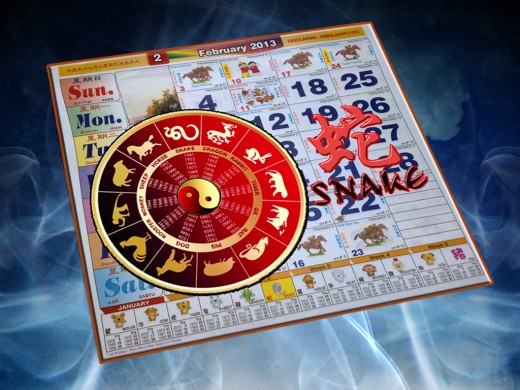
Twelve Animals In Chinese Astrology
During the Eastern Han Dynasty (25 - 220 AD), these Twelve Animals were used to link to the year in which a person was born. This eventually developed into an astrological system for divining one's fortune and became very popular among the royalties as well as the common Chinese people.
The "Twelve Animals" signs are colloquially known as "Twelve Birth Emblems" or "Twelve Signs of Belonging". People born during one of the animal's years are said to inherit distinctive personalities of that animal.
Briefly, the animal signs and their attributes are:
- Rat – ambitious and sincere;
- Ox – bright, cheery, and influential;
- Tiger – courageous and sensitive;
- Rabbit – talented and loving;
- Dragon – robust and passionate;
- Snake – wise and strong-willed;
- Horse – attractive and popular;
- Sheep – aesthetic and stylish;
- Monkey – persuasive and smart;
- Rooster – pioneer and wise;
- Dog – generous and loyal; and
- Pig – gallant and noble;
Beside "wise and strong-willed", Chinese astrologers also regard the Snake as mystical, graceful, soft-spoken, sensual, creative, prudent, shrewd, ambitious, elegant, cautious, responsible, calm, strong, constant, and purposeful.
Positive:
The Snake can be amiable, compromising, fun-loving, altruistic, honorable, sympathetic, philosophical, charitable, fashionable, intuitive, discreet, diplomatic, amusing and sexy.
Negative:
The Snake can also be self-righteous, imperious, judgemental, conniving, mendacious, grabby, clinging, pessimistic, fickle, haughty, ostentatious and a very sore loser.
Fascinating "Snake" Facts
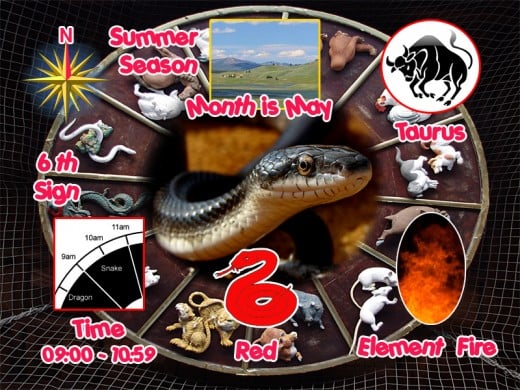
More Interesting Facts About The Astrological Snake
The Snake is ruled by the following attributes:
Yin/Yang: Yin
Position in Twelve Animals cycle: Sixth
Position in Trine: 2nd Trine (Ox, Snake, Rooster)
Season: Summer
Month: May
Hour: 09:00 to 10:59. This is the time when Snakes are leaving their caves.
Direction: North
Element: Fire
Color: Red
Equivalent Western Sign: Taurus
Snake Compatibility:
- Best Friends - Ox, Rooster, Dragon
- Friends - Rat, Rabbit, Monkey, Snake, Horse, Dog, Sheep
- Enemy - Pig, Tiger
A Trine Has The Combined Attributes of Three Animals
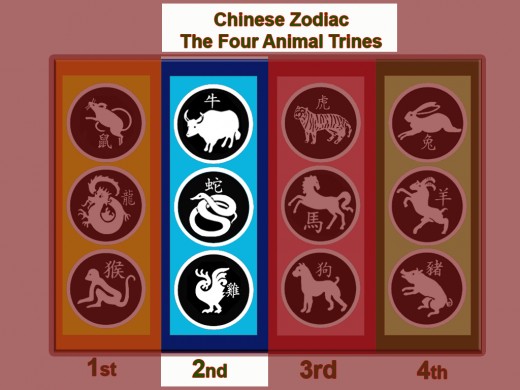
The Snake Is Grouped In The Second Trine
The Four Great Trines is another Chinese concept used by many astrologers to enhance the divination of a person's astrological chart. In this trine system, the Twelve Animals is divided in four trines or group of three animals based on the animals' personalities and compatibility:
- The First Trine (Rat, Dragon, Monkey)
- The Second Trine (Ox, Snake, Rooster)
- The Third Trine (Tiger, Horse, Dog)
- The Fourth Trine (Rabbit, Sheep, Pig)
Each Trine or team has the combined attributes of the three corresponding animals.
Attributes of The Second Trine - Ox, Snake and Rooster
The Snake is placed in the Second Trine category with the Ox and Rooster, and they share some common attributes:
- diligent,
- discreet,
- modest,
- industrious,
- charitable,
- loyal,
- punctual,
- philosophical, and
- patient.
Many Chinese astrologers believed that the Ox, Snake and Rooster are born leaders and are also known to be charitable persons with high moral standards.
On the down side, they can be self-righteous, vain, critical, judgmental, and petty.
From the Twelve Animals signs and the sub-category of the 2nd Trine of three animals signs, Chinese astrologers have come up with some fairly good perceptions of people governed by the Snake. Those born under the Snake sign also share similar perceptions of themselves for they have similar goals in life.
The two lists of famous Snake people reflected these perceptions and attributes of the Snake.
The lists comprise:
- ten prominent world leaders/politicians;
- three civil rights activists/journalists;
- two writers/journalists;
- seven famous actors/actresses;
- two financial experts;
- one business leader;
- two talk show hosts/TV celebrities/writers;
- two songwriters/singers;
- one philosopher;
- two musicians; one artist; and
- one sportsman.
Five Elements Cycle Overlays The Twelve Animals Cycle

Interactions Of The Five Elements Cycle On The Twelve Animals Cycle
It is important to know that not everyone born in Snake years would have the same attributes of the Snake because the Five Elements in the universe have great influence over each of the Twelve Animals. The Five Elements, in turn, are influenced by the Yin and Yang forces.
The Chinese Stem-Branch expression of year has a cycle of sixty years. Therefore, for each animal in the Twelve Animals cycle, there are five years having the same animal in this sixty-year calendar.
In Chinese culture, these five years of same animal correspond to different Five Elements of Metal, Wood, Water, Fire and Earth. Thus, for the past three cycles of 180 years, there were three Snake years with the same element:
- 1869 - Metal Snake
- 1881 - Wood Snake
- 1893 - Water Snake
- 1905 - Fire Snake
- 1917 - Earth Snake
- 1929 - Metal Snake
- 1941 - Wood Snake
- 1953 - Water Snake
- 1965 - Fire Snake
- 1977 - Earth Snake
- 1989 - Metal Snake
- 2001 - Wood Snake
- 2013 - Water Snake
- 2025 - Fire Snake
- 2037 - Earth Snake
The present Chinese Astrology 60-year Calendar (1984-2043), 1989 was a Metal Snake year while 2001 was Wood Snake year. Hence, the new year 2013 will be a Water Snake year.
Differentiating the Snake years into five sub-categories according to the Five Elements makes Chinese astrology more specific and concrete. Thus, persons born in the different Snake years will have different elements interacting and opposing the basic personalities of the Snake.
Water Snake Years: 1893 * 1953 * 2013
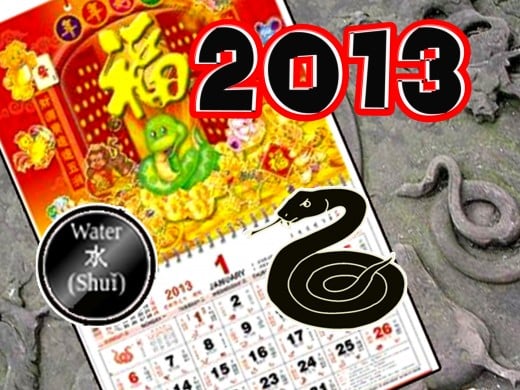
Year of The Water Snake or Black Water Snake
When the five-year Five Elements Cycle is placed over the original twelve-year Twelve Animals Cycle, the year 2013 is not only called the "Year of The Snake" but also popularly known as the "Year of the Water Snake" or sometimes as "Year of the Black Water Snake" because the Color of the Element Water is related to Black. This sub-category of the Water Snake will continuosly repeat itself every 60 years.
Water Snake Years: 1893 * 1953 * 2013
The corresponding dates in the Gregorian calendar are:
- February 17, 1893 to February 4, 1894,
- February 14, 1953 to February 2, 1954 and
- February 10, 2013 to January 30, 2014.
The Snake in the Twelve Animals cycle has Fire as its fixed element and the year 2013 has Water as its element. As mentioned earlier, the Five Elements have great influence over the Twelve Animals. For example:
If a Snake person's birth chart has too much Fire plus it's accompanying Yang force, it will disrupt the harmony of the person's Five Elements leading to conflict and trouble for the Snake.
Water plus it's Yin force is often regarded as the Snake person's Lucky Element for "Water puts out Fire" and it brings the Five Elements into balance again.
Therefore, Chinese astrologers generally believed that the element Water has tempered the fiery, "forked-tongue" Snake person into someone who is more toned down with very excellent communication skills and greatly admired.
This make Water Snake persons very influential, insightful, motivated, intellectual, determined and resolute about success. They will go to great lenghts to get what they want regardless of the consequences. They crave recognition and rewards for their efforts.
One good character of Water Snake persons is that they are affectionate with their families and close friends but do not show this good side of their personality to colleagues or business partners.
Thus, the Five Elements of a person's birth chart will have different elements interacting and opposing to shape and mold the person's destiny. It also give Chinese astrologers a more concrete and precise way to foretell a person's fate.
Your Destiny, Your Life
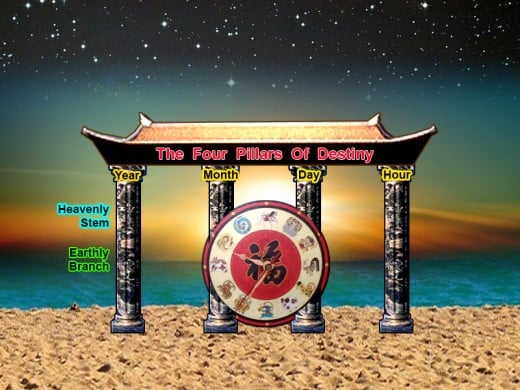
"The Four Pillars of Destiny/Life" or "Eight Characters" Fortune-Telling
"The Four Pillars of Destiny/Life" or "Eight Characters" Fortune-Telling adds a new dimension to Chinese astrology.
This system of divination uses the four "pillars" of birth - year, month, day, and hour to fortell a person's character and destiny as well as the opportunities and obstacles that may occur along the person's path of life.
The Four Pillars are linked to the Chinese Stem-Branch expression of year which has a cycle of 60 years and thus it can distinguish several millions types of people.
The description of each person's destiny and path of life is therefore more specific and concrete. It also covers the important people around a person and the opportunities, recognition, career, successes, wealth, obtacles, failures and many more aspects in a person's path of life.
When a person is born, the year, month, day and hour each has two Chinese characters forming a pillar. Each pillar has two Chinese characters (one character written on top the other to form a "pillar"), making it eight characters or commonly known as "Ba Zi" in Chinese.
The Chinese character on top of a pillar is called the Heavenly Stem representing the influence of the heavens.
The Chinese character at the bottom is called the Earthly Branch representing the influence from where we are on Earth.
Each pillar contains a stem and a branch which relates to the year, month, day and hour of birth.
Born in Snake Year But Is Also An Ox Internally, A Rooster Truly and A Horse Secretively
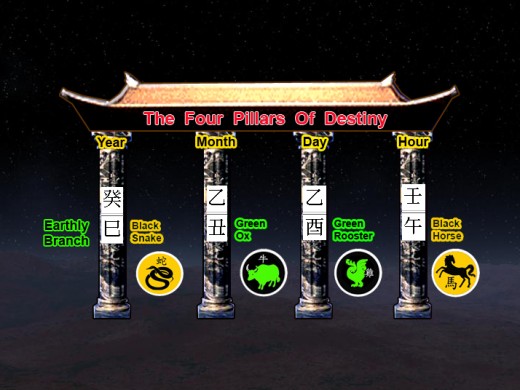
Not One, But Four Animals Governed Your Fate
Did you know that you are not solely governed by the Year Animal of your birth?
When you are born, there are other Animals assigned to you by Month, Day and Hour and they all play important roles in your destiny and path of life. It uses the same Twelve Animals signs but not the Chinese lunar calendar.
Instead it uses the Chinese agricultural or farmers' calendar. This calendar is divided into 24 two week segments known as Solar Terms. Each animal is linked to two of these solar terms or a month.
As it a solar month, it is thereby also linked to a Season. Since the Five Elements constitute everything in the universe, each of the elements is also linked to a season.
The Snake has Summer as its Season and Fire as its fixed Element. The two solar terms are from May 5 to May 20 and May 21 to June 5.
It is important to note that this fixed element is separate from the cycle of elements which interact with the signs in the 60 year cycle
Again, unlike the cycle of the lunar years, which begins with the Rat and ends with the Pig, the agricultural calendar cycle begins with the Tiger and ends with the Ox. The Tiger is chosen because it is the first animal of Spring.
The Four Pillars With Full Information Of Your Birth
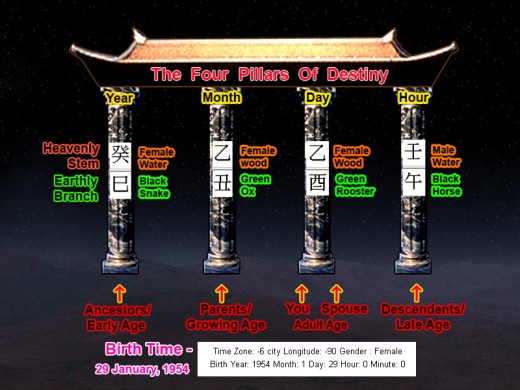
Your Fate and Life Written In The Four Pillars
Thus, the Four Pillars of Destiny contained information on each of the Twelve Animals and its Element as assigned according to a person's birth by Year, Month, Day and Hour.
- First Pillar - Year Animal & Element,
- Second Pillar - Month Animal & Element,
- Third Pillar - Day Animal & Element, and
- Fourth Pillar -Hour Animal & Element.
Also, within the Four Pillars are information about a person and people who are closest to and have some influence on the person's various life stages - ancestors, parents, spouse and descendants:
- Year Pillar - Ancestor or Early Age,
- Month Pillar - Parents or Growing Age,
- Day Pillar - You & Spouse or Adult Age, and
- Hour Pillar - Descendants or Late Age.
Thus, the Four Pillars or Eight Characters (Ba Zi) can be compiled into a comprehensive chart containing full information about a person's composition of Yin-Yang, the Five Elements and the Animals signs.
By carefully analyzing this information and the interaction of the characters with each other, well-versed astrologers can foretell the characteristics of an individual and the relationship between the person with the surrounding environment.
"Luck Pillar" Chart of A Yin Male
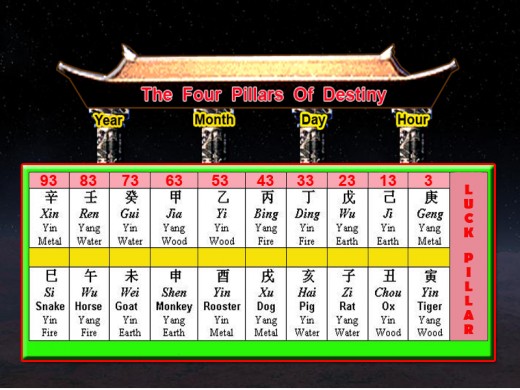
10-Year Luck Pillars
The Four Pillars chart can also forecast the strengths and weaknesses in a person's destiny which represents the ups and downs of life by comparing the interaction of the Four Pillars chart with the 10-Year Luck Pillars.
Four Pillars or Eight Characters Fortune-telling is not only very popular among the Chinese but also among the Japanese and Koreans as well who have their own similar concepts and methods of divination.
Many rich and prominent people especially politicians, celebrities and business people use this divination method to chart their actions and do whatever it take to achieve fame and fortune.
Same Birthdays But Different Destinies

Why Do Persons Sharing The Same Birthdays End Up Differently?
The answer is obvious.
Astrological predictions only cover a part of a person's destiny. The most important part that is NOT covered by many astrologers is how a person perceived oneself and what actions has the person taken to achieve one's goals. And there are boundless other variables, known and unknown, that could also influence a person's fate as well as the surrounding environment.
Many well-versed astrologers from the various schools of divination acknowledge that the Chinese astrological system is evolving all the time. Observations on millions of people born under the various animal signs need to be checked and verified constantly. Methods of compiling, analyzing and interpreting birth charts need to be continuously fine-tuned for relevance and accuracy.
Some would claimed that their divination systems are the best. But, the variations involved are infinite and cannot be covered well even with the latest computer programs. It may work sometimes but not all the time.
After understanding the basic concepts of Chinese astrology, even you can make some general predictions of your fate. Try it, it's lots of fun.
Just do a search on "Chinese Astrology" on the web and you will find plenty of free tools to encode and decode your astrological birth chart.
A Sincere Wish To All Chinese Readers...








